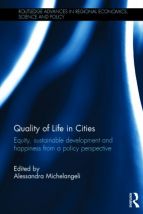Quality of Life in Cities: Equity, Sustainable Development and Happiness from a Policy Perspective

Quality of Life in Cities is particularly useful for economists and statisticians, as it is interested more in ways to measure urban quality of life than in the theory or grounded reality of variations in quality of life.
Chapter 1 gives an overview of urbanization: the history of cities, models for urban growth and the spatial distribution of cities, and forecasts for city size.
Chapter 2 describes the method most commonly used by economists to measure urban quality of life: the hedonic price method. Hedonic value is calculated according to an index made up of a bundle of local goods and services, from school quality to air quality, which are assigned monetary values. Economists can then determine comparative quality of life according to the value of the amenities in a particular city or neighbourhood.
Chapter 3 explores a newer method for measuring quality of life: the life satisfaction approach. While the hedonic price method indirectly estimates local preferences, using prices in local markets, the life satisfaction approach directly assesses these preferences. “This method is based on the assumption that local amenities (or dis-amenities) contribute to determine individual overall well-being. Self-reported life satisfaction, used as a proxy for subjective well-being, is thus modelled as a function of local amenities.” (page 67) The chapter analyses data from Italian cities to show how the method is used, and the differences in results between the hedonic price and life satisfaction frameworks.
Chapter 4 examines how equity affects urban quality of life. It outlines the harmful effects of inequality on urban growth and happiness. And it explains the methodology used for spatial analysis of equality, as well as the limitations of this in accurately describing multidimensional wellbeing.
Chapter 5 conceptualizes quality of life as one element of urban sustainability. It draws on newer modelling and simulation techniques to “explore disaggregate models and in particular the distinction between individual and household well-being, and how it affects their decisions” (page 111). These techniques are applied to sample cases such as commuting time and couples’ transport choices, showing how individual and household wellbeing can be distinguished.
Chapter 6 tackles the debate around whether there is an optimal city size. It concludes that efficient size is ultimately more important than optimal size, and that “investment should be devoted to cities in order to enable any of them, despite their size, to turn their risk of decreasing returns into agglomeration economies, by investing in the renovation [of] their functions and their ways of cooperation” (page 161).
Further reading:
Ballas, Dimitris (2013), “What makes a ‘happy city’?”, Cities Vol 32, Suppl 1, pages S39–S50, available at http://www.sciencedirect.com/science/article/pii/S0264275113000504.
Jirón, Giulietta Fadda Paola (1999), “Quality of life and gender: a methodology for urban research”, Environment and Urbanization Vol 11, No 2, pages 261–270, available at http://journals.sagepub.com/doi/abs/10.1177/095624789901100220.
Luger, Michael I (1996), “Quality-of-Life Differences and Urban and Regional Outcomes: A Review”, Housing Policy Debate Vol 7, No 4, pages 749–771, available at https://www.innovations.harvard.edu/sites/default/files/hpd_0704_luger.pdf.
Book note prepared by Christine Ro
Search the Book notes database
Our Book notes database contains details and summaries of all the publications included in Book notes since 1993 - with details on how to obtain/download.
Use the search form above, or visit the Book notes landing page for more options and latest content.
For a searchable database for papers in Environment and Urbanization, go to http://eau.sagepub.com/

